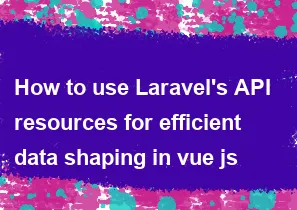How to use Laravel's API resources for efficient data shaping in vue js

Laravel's API resources are a powerful tool for transforming your Eloquent models and model collections into a properly formatted JSON response. When combined with Vue.js on the frontend, you can efficiently shape and display data in your application.
Here's a step-by-step guide on how to use Laravel's API resources with Vue.js:
1. Create API Resource
Create a new API resource using the artisan command:
bashphp artisan make:resource PostResource
This will generate a new resource file in the app/Http/Resources directory.
2. Define Transformation in the Resource
In the newly created resource file (PostResource in this case), you can define how your data should be transformed. For example:
php// app/Http/Resources/PostResource.php
namespace App\Http\Resources;
use Illuminate\Http\Resources\Json\JsonResource;
class PostResource extends JsonResource
{
public function toArray($request)
{
return [
'id' => $this->id,
'title' => $this->title,
'body' => $this->body,
'created_at' => $this->created_at->toDateTimeString(),
'user' => new UserResource($this->whenLoaded('user')),
];
}
}
In this example, UserResource is another API resource that represents the user associated with the post.
3. Use the Resource in the Controller
In your controller, use the resource to shape the data before sending it as a response:
php// app/Http/Controllers/PostController.php
use App\Http\Resources\PostResource;
public function index()
{
$posts = Post::with('user')->get();
return PostResource::collection($posts);
}
4. Fetch Data in Vue.js
Use a tool like Axios to make a request to your Laravel backend and fetch the data in your Vue.js component:
javascript// Your Vue.js component
<template>
<div>
<div v-for="post in posts" :key="post.id">
<h2>{{ post.title }}</h2>
<p>{{ post.body }}</p>
<p>Created by: {{ post.user.name }}</p>
</div>
</div>
</template>
<script>
export default {
data() {
return {
posts: [],
};
},
mounted() {
this.fetchPosts();
},
methods: {
async fetchPosts() {
try {
const response = await axios.get('/api/posts');
this.posts = response.data.data;
} catch (error) {
console.error('Error fetching posts:', error);
}
},
},
};
</script>
5. Display Data in Vue.js Component
Now, your data is shaped and ready to be used in your Vue.js component. The PostResource ensures that the data sent from Laravel is in the desired format, making it easier to work with in your frontend.
Remember to adjust the code according to your specific use case, and consider adding pagination if you have a large dataset. Laravel provides pagination support, and you can handle it on the Vue.js side as well.
-
Popular Post
- How to optimize for Google's About This Result feature for local businesses
- How to implement multi-language support in an Express.js application
- How to handle and optimize for changes in mobile search behavior
- How to handle CORS in a Node.js application
- How to use Vue.js with a UI framework (e.g., Vuetify, Element UI)
- How to configure Laravel Telescope for monitoring and profiling API requests
- How to create a command-line tool using the Commander.js library in Node.js
- How to implement code splitting in a React.js application
- How to use the AWS SDK for Node.js to interact with various AWS services
- How to use the Node.js Stream API for efficient data processing
- How to implement a cookie parser middleware in Node.js
- How to implement WebSockets for real-time communication in React
-
Latest Post
- How to implement a dynamic form with dynamic field styling based on user input in Next.js
- How to create a custom hook for handling user interactions with the browser's device motion in Next.js
- How to create a custom hook for handling user interactions with the browser's battery status in Next.js
- How to implement a dynamic form with dynamic field visibility based on user input in Next.js
- How to implement a dynamic form with real-time collaboration features in Next.js
- How to create a custom hook for handling user interactions with the browser's media devices in Next.js
- How to use the useSWRInfinite hook for paginating data with a custom loading indicator in Next.js
- How to create a custom hook for handling user interactions with the browser's network status in Next.js
- How to create a custom hook for handling user interactions with the browser's location in Next.js
- How to implement a dynamic form with multi-language support in Next.js
- How to create a custom hook for handling user interactions with the browser's ambient light sensor in Next.js
- How to use the useHover hook for creating interactive image zoom effects in Next.js